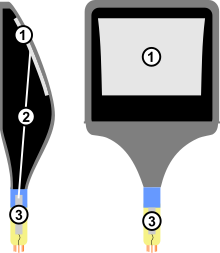Handheld television
This article needs additional citations for verification. (January 2021) |
A handheld television is a
handheld transistor radios
.
History

In 1970,
CRT
which set the record for being the smallest CRT on a commercially marketed product.
Later in 1982,
active-matrix LCD was released. Some smartphones
integrate a television receiver, although Internet broadband video is far more common.
Since the switch-over to digital broadcasting, handheld TVs have reduced in size and improved in quality.[dubious ][citation needed] Portable TV was eventually brought to digital TV with DVB-H, although it didn't see much success.
Hardware

These devices often have stereo 1⁄8 inch (3.5 mm)
phono plugs for composite video-analog mono audio relay to serve them as composite monitors; also, some models have mono 3.5 mm jacks for the broadcast signal that is usually relayed via F connector or Belling-Lee connector
on standard television models.
Some include
SD
ports.
Screen sizes vary from 1.3 to 5 inches (33 to 127 mm). Some handheld televisions also double as portable DVD players and USB personal video recorders.
Size
Portable televisions cannot fit in a pocket, but often run on batteries and include a
cigarette lighter receptacle
plug.
Pocket televisions fit in a pocket.
Wearable televisions sometimes are made in the form of a
wristwatch
.
Notable brands and models
See also
- Handheld electronics
References
- ^ "1970年代 カラーテレビの普及が加速 | パナソニック テレビと家電の歴史 | テレビ ビエラ | 東京2020オリンピック・パラリンピック公式テレビ | Panasonic". panasonic.jp (in Japanese). Retrieved 2020-04-11.
- ^ "Sony Japan | Sony Design|History|1980s". www.sony.co.jp (in Japanese). Retrieved 2020-04-11.
